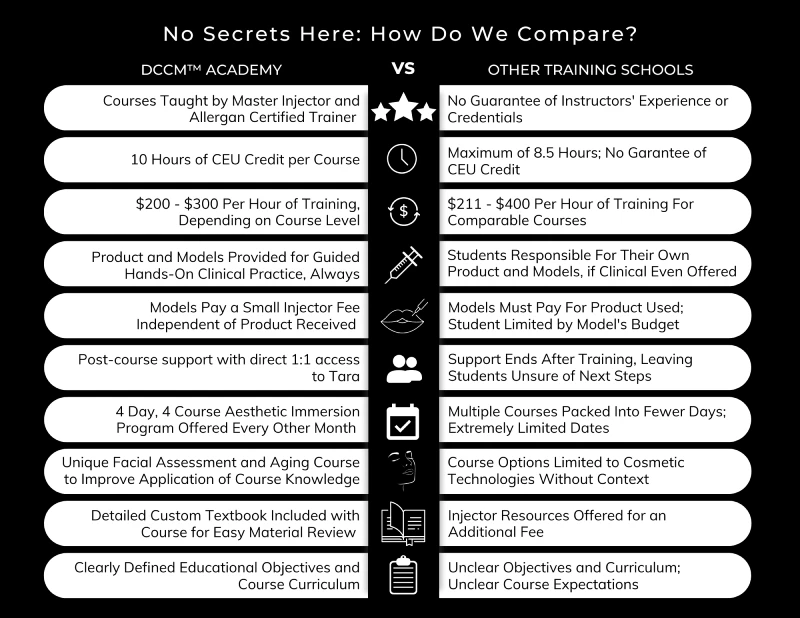Dermal Filler Adverse Event Management
Having the Conversations with Your Patient About a Dermal Filler Adverse Event.
Be sure to discuss the following topics with your patient:
- Counsel on bruises
- Counsel on anticipated pain
- Discuss what swelling will be like
- Send follow-up emails with reminders of what to expect, along with post-care instructions.
- Call the next day to follow up
- Schedule a two-week follow up
- Provide them with your after-hours emergency contact

Additional preventative measures
Assessment during treatment
Keep an eye on the skin color
Asking patients frequently if they are ok
Many aesthetic injectors need help with informed consent for one of two reasons. First, they need more confidence in managing adverse events. The second reason is they need to figure out how to effectively communicate this process with the patient without scaring them away from its treatment. I have developed a list of ways to help aesthetic injectors develop confidence in informed consent beyond the foundation of anatomical and pharmacologic comprehension.
Steps to effective communication with your patient
- Rapport. Do not just treat any patient for the money. If you question whether or not treatment is a good idea, then it likely is not a good idea; therefore, trust your gut. As excited as we are to have patients in our chairs, we ultimately choose them as their caregivers. If you are suspicious of their behaviors, they will likely not be compliant in an adverse event situation nor happy with the result.
- Explain. I teach all my patients as if they are a student. I take time to provide great detail in reviewing the treatment and the risks with the patient. This minimizes the shock and terror if they have an adverse event. Fear of the unknown is more anxiety-producing than fearing the known. It has been argued that fear of the unknown is actually a fundamental fear! Fear of the unknown is fear of the perceived absence of information at any level of consciousness or any point of intellectual processing
- Show them that you are the expert but also be humble. No matter your mastery level, please know that medicine is still the “practice of medicine”: they call it this for a reason. We have guidelines but think of the 8 billion people in the world; I am confident that every genetic makeup of all 8 billion will not follow cookie-cutter suit to conform to the diagnosis. We need to conform to the individual, not to the treatment. This means not every adverse will respond the same or present the same. The patient’s fears and anxiety or stoic nature will all play into how the handling and management of the situation
- Practice. You can demonstrate this to your patients by showcasing your awards, certificates, and resume online. (CLICK here to see my Curriculum Vitae). Ultimately, you need to become an expert, no matter your degree. When you are the one injecting, it all falls on you.
- Empathy. This goes without saying; we can demonstrate empathy by being relatable. Share your fears or perhaps insecurities with the patient. If you are an injector that hasn’t been injected, this can be unsettling to the patient; however, even worse is an over-filled injector.
- Collaboration. Collaboration is critical in aesthetic medicine; you must have partners in this industry for peace of mind. You will also want to demonstrate that you are not on your own little independent island and that you have a support network and others to call, others you have learned from.
- Technology. Technology can add a tremendous amount of value to educating your audience. Pick one platform, and communicate with your patients/audience frequently. I created a prep email for my patients that helps keep them in control of their knowledge. I also have a post-treatment email for them, and this reiterates everything I said during the consultative process.
- CONSENT. The consent is both verbal and written. This is a process you are legally bound to perform. Move beyond the signature on the iPad and discuss risk versus benefit with your patient. This process will further develop the relationship as it demonstrates that you can be trusted. Explain everything to your patients, including the risk of nodules, occlusion, stroke, blindness, an outbreak of herpes, lymphatic stalling due to Neurotoxin in the periorbital area, Tyndall, periorbital edema, granuloma, even the little migrated or misplaced filler, biofilm, all of these are in my consent form and are a part of my conversation. Then I verbally tell them about the reversal process, and this consent is embedded within the filler consent. I recently added an arbitration agreement as well to my consent. You must have complicity in the face of an adverse event. Otherwise, you can’t help. I tell my patients this is so specialized that their primary care provider and emergency room cannot help. A vascular occlusion is an Emergency, and you are in the Emergency Room. However, with educated patients and safe practitioners, vascular occlusion is more of a nuisance than life-threatening. The treatment of nodules is also the aesthetic injector’s responsibility. This may shock you, but there are physicians, Nurse Practitioners alike that do not know the difference between Botox and filler.


Tara Delle Chiaie
My name is Tara and I am the owner of Delle Chiaie Cosmetic Medicine. I have been in medicine since 2002 as a Registered Nurse. In 2011 I graduated from the accelerated program at the University of New Hampshire (UNH) as an Advanced Practice Registered Nurse (APRN). My goal is to continually fine-tune the art of bringing one’s inner beauty to the surface.
2023 Course listings
- January 3rd-6th
- March 7th-10th
- May 2nd-5th
- August 1st-4th (Sold Out)
- September 5th-8th
- November 7th-10th
MEET
Tara Delle Chiaie
DNP, MSN, FNP-BC, APRN, ABAAHP
Owner/Master Aesthetic Injector
My name is Tara and I am the owner of Delle Chiaie Cosmetic Medicine. I have been in medicine since 2002 as a Registered Nurse. In 2011 I graduated from the accelerated program at the University of New Hampshire (UNH) as an Advanced Practice Registered Nurse (APRN) and immediately became nationally recognized through the American Nurses Credentialing Center (ANCC) as a Board Certified Nurse Practitioner. I grew up in the beauty industry and found it was a great union to blend beauty with medicine. I have an astute sense of safety, while my experience guides my practice to produce beautiful and natural results. My goal is to continually fine-tune the art of bringing one’s inner beauty to the surface.


Let's Talk About
Your Career
*By submitting this form you agree to be contacted by DCCM Academy
and receive marketing messages by phone, text, or email. You can unsubscribe from these communications at any time. We commit to protecting and respecting your privacy. For more information, please review our Privacy Policy.

